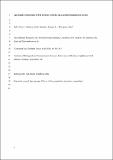Age–length relationships in UK harbour seals during a period of population decline
Abstract
1. The abundance of harbour seals (Phoca vitulina) in the UK as a whole has increased over the past 10 years, after a 30% decline during the preceding 10 years and two major viral epidemics. However, population trends vary greatly among regions, with those on the east coast of Scotland and in the Northern Isles experiencing dramatic declines since the early 2000s and populations on the west coast being either stable or increasing. The reasons for these differences in population dynamics are unknown. 2. Determining whether there has been a change in somatic growth among populations can assist in assessing potential causes for abundance declines, as shifts in juvenile growth rates or maximum length at maturity may indicate changes in environmental conditions. Resource limitations are likely to result in slower growth and later age at sexual maturity, whereas causes of acute mortality could have the opposite effect. 3. Here, analysis of the most comprehensive length‐at‐age dataset for UK harbour seals found no evidence for major differences, or changes over time, in asymptotic length or growth parameters from fitted von Bertalanffy growth curves, across all regions, with the exception of one pairwise comparison; males from East Scotland were significantly shorter than males from all other areas by an average of almost 9 cm. However, the power to detect small changes was limited by measurement uncertainty and differences in spatial and temporal sampling effort. 4. Asymptotic lengths at maturity across all regions were slightly lower than published lengths for harbour seal populations in Europe, the Arctic, and Canada, with females being on average 140.5 cm (95% confidence interval 139.4, 141.6 cm) and males 149.4 cm (95% confidence interval 147.8, 151.1 cm) at adulthood. 5. Reliable estimates of changes in growth over time are important for understanding environmental constraints on a population, but knowledge of the underlying drivers of change is essential for the design of robust conservation and mitigation plans.
Citation
Hall , A J , Mackey , B , Kershaw , J L & Thompson , P 2019 , ' Age–length relationships in UK harbour seals during a period of population decline ' , Aquatic Conservation: Marine and Freshwater Ecosystems , vol. 29 , no. S1 , pp. 61-70 . https://doi.org/10.1002/aqc.3104
Publication
Aquatic Conservation: Marine and Freshwater Ecosystems
Status
Peer reviewed
ISSN
1052-7613Type
Journal article
Description
We would like to thank Scottish Natural Heritage, the Scottish Government and the UK Natural Environment Research Council (grant code SMRU/10001) for funding this study.Collections
Items in the St Andrews Research Repository are protected by copyright, with all rights reserved, unless otherwise indicated.

